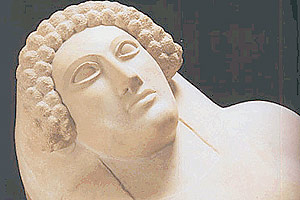The Phoenician civilization never identified itself as such, as there was never a country called Phoenicia. The Greeks, the great chroniclers of the history of this empire, gave them this name which means «Purple». This was because they were the inventors of the dye extracted from the murex mollusk. They settled in lands currently part of Lebanon in the year 1200 A.C., from where they exerted a powerful influence as traders and sailors throughout the Mediterranean.
The country’s official name is the Lebanese Republic and it is located in Western Asia. It is bounded in the north and east by Syria, by Israel in the south and by the Mediterranean in the west. It is inhabited by close to 4 million people and its capital is Beirut. The population, which is composed mainly of Lebanese and to a lesser extent Armenians and Palestinian refugees, is concentrated mainly in the coastal cities and the Bekáa depression, where the most important rivers such as the Orontes and the Litani run. Arabic is the official language, although most of the people also speak English and French. The climate on the coast is Mediterranean, with fresh winters and hot summers, and the interior is rainier and more humid.
The struggle for a free country
Lebanon became a French mandate after the First World War in April 1920, and the coast, inhabited mostly by Muslims, was united with the mountain area, dominated by Christians, to form the Lebanese Republic. This only lasted until 1943, when it became independent. From that point onwards, Lebanon became an important trading center, but there were serious religious problems, as power remained in Christian hands and the Muslims who accounted for almost half of the population felt excluded from government. In addition to this, a large number of Palestinian refugees arrived in the country after Israel was founded. This upset the balance and the country divided, leading to a civil war in 1975 that lasted until 1989, when due to strong international pressure, mainly of the USA and France, a national reconciliation agreement was signed. This established the distribution of power between the different communities, and worked out favouring the Muslim community. At the same time Syria obtained political custody over Lebanon, but in 2004, after a resolution of the UN Security Council the withdrawal of Syrian military forces was ordered, although this only took place a year later.
Form of government
The Lebanese Government is republican and consists of the President, General Emile Jamil Lahoud and the Prime Minister Faud Siniora, who is chosen by the President in consultation with the National Assembly.
Legislative power is unicameral, only the Chamber of Deputies exists. Christians and Muslims have an equal share of the seats of Parliament.
Suffrage is compulsory for all citizens over the age of 21. The judiciary has four courts of appeal, three are civil and commercial and one is criminal.
To ensure that no minority in the country is marginalised from the government, the convention is that the President is a Maronite Christian, the Prime Minister is a Sunni Muslim and the Speaker is a Druze (Sh’ia Muslim).
Great exporters
The civil war considerably damaged Lebanon’s economic structure, as productivity noticeably declined and Beirut’s fame as the financial paradise of the Middle East was bought to an end. Nevertheless, today the economy has made notable progress with government assistance, adopting a programme of fiscal adjustment based on taxation, the privatisation of state-owned enterprises and improving the management of national debt, still very high. Besides this, the recovery has been supported by an efficient banking system and by manufacturing practices which have favoured small and medium sized businesses.
Lebanon’s main sources of income are the following: textile exports; food exports such as potatoes, olives tobacco, lamb and salt; petroleum refinement; cement; chemical products; metal such as iron and aluminium; limestone and jewellery, amongst others.
Arabic cultural capital
Despite it being disrupted by an internal war, Lebanon has always had significant cultural heritage. Many relics of the Phoenician civilisation, such as jewellery and pottery, sarcophagi such as that of the King of Byblos, and the first symbols of the alphabet which appear in the «Tomb of Hiram» (a Tyrean King), are kept in the National Museum of Beirut.
Theatre in Lebanese society is highly valued since its works faithfully reflect the nation’s sufferings, joys and passions.
Their form of poetry is known as zajal. This is an ingenious dialogue in which a group of poets improvises verses, incorporating them into songs. Among contemporary writers Amin Maalouf, Emily Nasrallah and Hanan Al-Shaykh stand out.
Modern Lebanese sculpture has been influenced in recent times by western, especially abstract sculpture. The most well known artists in this field are Maroun Al Hakim, Alfred and Jaseph Basbous.








 Muere Evita
Muere Evita